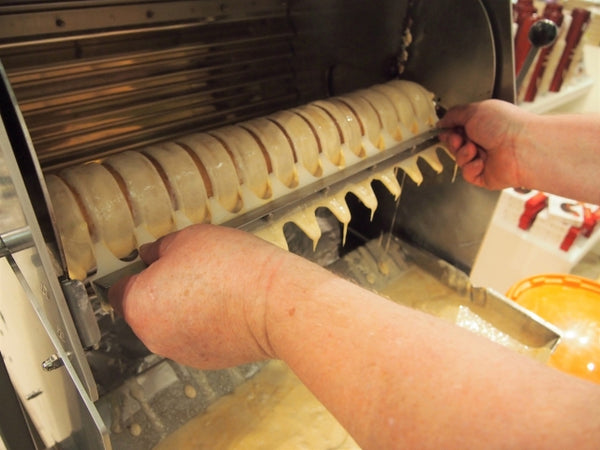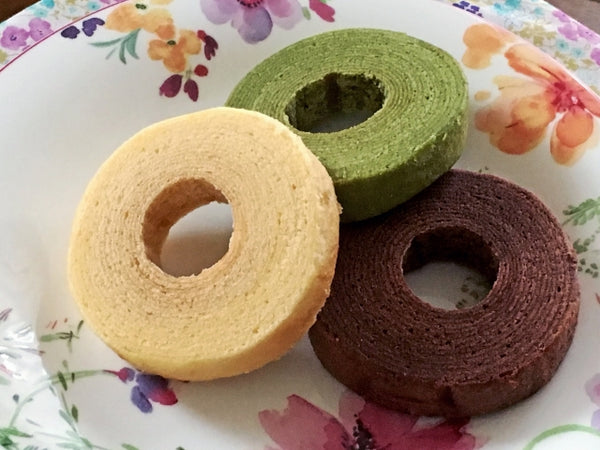Baumkuchen: Exploring the Origins of German 'Tree Cake' in Japan

It is easy to see how Baumkuchen, which literally translates from German to “tree cake,” gets its name. Slicing into Baumkuchen reveals the cake’s concentric circles reminiscent of a tree’s annual growth rings.
Made from a thin batter of flour, eggs, sugar, vanilla, salt, and butter, it is also easy to see how this confection—with its aesthetic appeal and a mellow flavor which pairs well with chocolate, green tea, or berries—has gained intense popularity in Japan.
Unknown Origins
The version of Baukuchen which has taken Japan by storm originated in Germany, but spit-roasted cakes (such as Polish Sekacz, Lithuanian Sakotis, and Swedish Spettekaka) exist all across Europe. The first known preserved recipe for these types of cakes comes from an Italian cookbook dating back to 1426, but records indicate that Baukuchen-like cakes were made by the ancient Greeks.
The “Cake of Kings” and the “King of Cakes”
Baumkuchen is known as the “cake of kings.” The confection was a favorite of King Friedrich Wilhelm IV of Prussia who allegedly was so enthralled with the cake during his trip to the German town of Salzwedel that he ordered the meisters to serve up a whole other cake to go.
Not only the “cake of kings,” Baumkuchen is also known as the “king of cakes” due to the extreme complexity and dedication required in baking this cake. Likewise, Baumkuchen is used in the German Confectioners’ Guild’s logo for the very same reason.
In order to make Baumkuchen, a certified meister must stand constant watch over a specialized oven which bakes the cake on a spit like a rotisserie for anywhere from 40 to 90 minutes. During this time, the meister adds thin layers of batter to the rotating cake, smoothing it out and ensuring that each layer is evenly baked before adding another ring. Baumkuchen has anywhere from 15 to 25 layers, can weigh upwards of 100 lbs, and can often fall off the spit or lose its shape if not crafted carefully.

Given the specialized equipment and amount of time required in baking Baumkuchen, it is understandable that the delicacy is often reserved for special occasions, such as Christmas, and can often be difficult to find out of season.
While tourists may be hard-pressed to find Baumkuchen in Germany, the cake can be found everywhere in Japan from fashionable cafes to convenience store shelves—fortunate for travelers with a sweet tooth. However, the story of how this notoriously difficult cake to bake made its way from Germany to Japan is not so fortunate for the man who started it all.
One man’s series of unfortunate events
Karl Joseph Wilhelm Juchheim was a German baker who, at the age of 22, moved to the German protectorate Tsingtao, China to run his own pastry shop. Shortly after Juchheim and his wife Elise opened their second shop in Jiaozhou Bay, Juchheim was captured by Japanese troops during the Siege of Qingdao.
Juchheim and his wife were taken to a prisoner-of-war camp on Hiroshima’s Ninoshima island in the Seto Inland sea. In March of 1919, about 5 years into his internment, Juchheim was requested to participate in a “German Prisoners of War Technology and Crafts Exhibition” in the Hiroshima Prefectural Commercial Exhibition Hall, currently known as the Atomic Bomb Dome. It was here that the Japanese public tasted Juchheim’s Baumkuchen for the first time, and they were immediately hooked. The Chugoku Shimbun reported that Juchheim’s exhibit was the most popular, and it is quite likely that this popularity is what prompted Juchheim to stay in Japan and open up a bakery in Yokohama upon his release.
However, just two years after opening their Yokohama bakery, Juchheim was once again met with misfortune in the form of the Great Kanto Earthquake. It was reported that Juchheim relocated to Kobe and borrowed a large sum of money to make one final attempt at operating a successful bakery in Japan.
And successful it was. The public, once again, took an immediate fascination with Baumkuchen—eventually assigning their own meanings to the cake, associating the concentric rings with luck and longevity. Ironically, while Baumkuchen’s rings represent seemingly infinite luck to the Japanese, the ill-fated Juchheims’ luck ran dry once again.
The Second World War brought butter rations and food scarcity to Japan, forcing the Juchheims to close down their bakery. Karl passed away before the end of the war and Elise was deported back to Germany.
Rings of Luck
Perhaps inspired by their former boss’ tenacity, Juchheim’s apprentices reopened the bakery after the conclusion of World War II. Elise was eventually allowed to return to Japan and serve as the chairman of the Juchheim group—which still produces Baumkuchen over 100 years after Karl first introduced the cake to Japan.
Considering the astounding popularity of Baumkuchen in Japan despite all the setbacks the Juchheims faced lends credibility to the notion that Baumkuchen truly does represent luck and longevity.

Today, Baumkuchen can be found throughout Japan in the traditional vanilla sponge cake version, but also in a variety of interesting and seasonal flavors such as matcha, sweet potato, and strawberry—or even baked around whole fruit such as apples or pears.

But no matter if you buy your Baumkuchen from a fashionable Tokyo cafe or a roadside station gift shop, be sure to take a moment to appreciate the delicate rings and the efforts put forth by the bakers and the Juchheims to bring this sweet treat into the limelight.
About the author:

Kimberly Matsuno
Kimberly Matsuno is a professional content writer and editor from the US. Having spent several years living in the Japanese countryside, Kimberly holds a particular fondness for Japanese culture and cuisine—particularly anything made with shiso. You can view more of her work at kimberlymatsuno.com.




